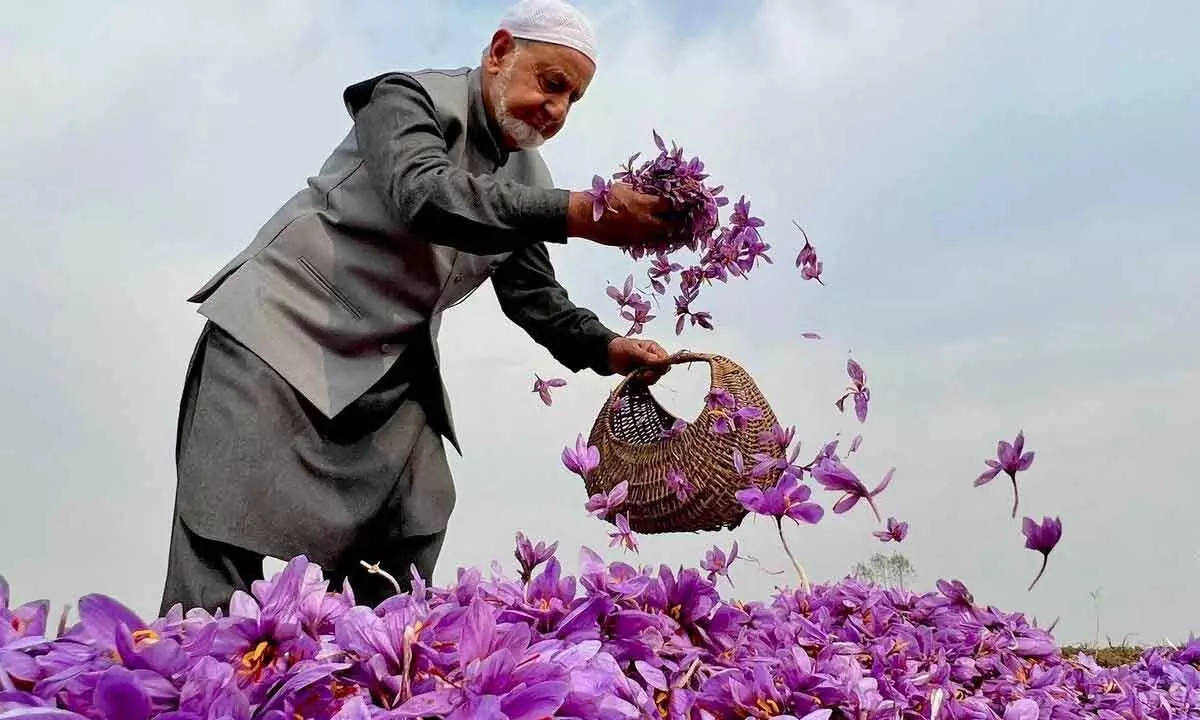Riyaz Masoodi: Championing Kashmir’s saffron, from tradition to modern markets
In 1975, my father initiated wholesale saffron trading outside the state, garnering a tremendous response, says Crimson’s Riyaz Masoodi
image for illustrative purpose

We primarily pack saffron cultivated from our farms and also procure raw material (Laccha) from local saffron growers in Pampore, processing it under strict supervision. Sourcing Kashmiri saffron mandates collaboration with reputable suppliers/producers near the Pampore region, ensuring adherence to quality and authenticity standards - Riyaz Masoodi, a third-generation saffron grower
Saffron, an enduring cash crop, plays a vital role in defining Kashmir's identity. Renowned for its high value, this spice is a crucial export commodity, positioning Kashmir as the world's second-largest contributor to the global saffron market. It employs roughly 5 per cent of the rural workforce in the valley. Pampore, nestled beneath the Himalayas in Indian-administered Kashmir, stands as a key centre for saffron cultivation.
The National Saffron Mission, initiated amidst challenging socio-political and economic circumstances, aimed to boost saffron cultivation in Kashmir. Introduced in 2011 and reinvigorated in 2020 under the Rashtriya Krishi Vikas Yojana in 2014, its primary goal was to uplift the socio-economic status of 30,000 Kashmiris reliant on saffron farming. With the spice attaining GI tag certification and securing a Grade 1 rating for quality, the price of this 'red gold' now stands on par with the value of gold itself.
The current market price of saffron in India hovers around Rs 3 lakh per kg, while the specific variant 'kesar' fetches approximately Rs 110,000 per kg. Even a pinch or gram of saffron costs around $3 or Rs 250 for consumers in the market.
Recent research indicates that the global saffron market reached an estimated value of $875.5 million in 2022. Projections suggest substantial growth, with an expected size of $1,517.4 million by 2028, reflecting a Compound Annual Growth Rate (CAGR) of 9.6 per cent during the 2022-2028 period.
Furthermore, India demonstrated its market presence by exporting saffron worth $244,871.70 between 2022-2023.
Riyaz Masoodi, a third-generation saffron grower in Namblabal, Pampore, shares insights into his company, “Crimson,” and the pride of saffron growers in the valley.
Reflecting on the legacy shared with his family of saffron growers and traders, Riyaz Masoodi highlights their century-long heritage in saffron cultivation. “In 1975, my father initiated wholesale saffron trading outside the state, garnering a tremendous response. By 1992, we began retail packaging under the brand 'Crimson,' successfully selling Kashmir saffron both offline and online at www.buycrimson.com.”
When questioned about sourcing methods, considering specific growth requirements, Riyaz emphasizes, “We primarily pack saffron cultivated from our farms and also procure raw material (Laccha) from local saffron growers in Pampore, processing it under strict supervision. Sourcing Kashmiri saffron mandates collaboration with reputable suppliers/producers near the Pampore region, ensuring adherence to quality and authenticity standards.”
Highlighting the significance of their niche saffron brand, Riyaz details their cultivation across 10 acres, combining saffron from their farms and locally procured raw materials. He stresses the importance of collaborating with reputable suppliers to meet Kashmir's specific growth requirements while maintaining authenticity and quality.
Commenting on challenges due to farmers cultivating saffron outside its natural habitat, Riyaz notes, “Efforts beyond Kashmir encounter challenges in replicating specific growth conditions essential for saffron. These ventures may impact local businesses but traditional Kashmiri saffron’s quality and authenticity mitigate some competitive pressures. Adaptation and innovation within Kashmir’s saffron industry are essential for sustaining its premium status.”
Climate change impacts saffron's quality, affecting essential compounds like crocin and safranal. El Nino's effects, causing dry spells and inadequate rainfall, diminish corm size and yields, impacting market prices and returns.
Speaking about climate changes affecting saffron, Riyaz says, “Increased temperatures lower saffron quality, potentially reducing valuable compounds like crocin and safranal. Drought conditions lead to reduced corm size and yields, causing supply fluctuations impacting market prices.”
According to a report by Future Market Insights, the global saffron market is estimated to reach $876.8 million by 2033, with a projected CAGR of 5.2 per cent through 2033. The Indian saffron market is expected to exhibit a growth rate (CAGR) of 15.10 per cent during 2023-2028. Riyaz finds optimism in this report, suggesting steady and significant growth, driven by consumer appreciation for saffron's unique attributes.
The Indian Saffron Market's 15.10 per cent CAGR growth may stem from increased domestic consumption, exports, and a growing interest in saffron in traditional Indian cuisines and Ayurvedic practices.
Regarding preserving key saffron compounds, Riyaz assures proper harvesting, drying, stringent quality testing, and certified storage for optimal periods.
Saffron's versatility in culinary dishes, beverages, and medicinal products appeals to various industries. Growing awareness of its potential health benefits and expansion beyond traditional regions could boost consumption. However, labour shortages and climate change pose challenges.
Riyaz emphasizes Crimson's educational approach, focusing on saffron's applications, culinary uses, health benefits, and a strong online presence.
Speaking about the distribution of saffron given that its freshness and quality are retained, Riyaz details they have established strategic alliances with trusted logistics firms that guarantee punctual delivery, playing a pivotal role in maintaining the freshness and quality of their saffron.
Looking ahead, Crimson's endeavours extend beyond the traditional saffron market. The company's active involvement in supplying saffron to various industries—ranging from cosmetics to food and beverages—spotlights potential avenues for growth and diversification. However, it's not just about expansion; Crimson champions sustainability. Practices like soil conservation, ethical sourcing, and ongoing research into sustainable cultivation methods underscore the company's commitment to nurturing both the environment and its trade.

